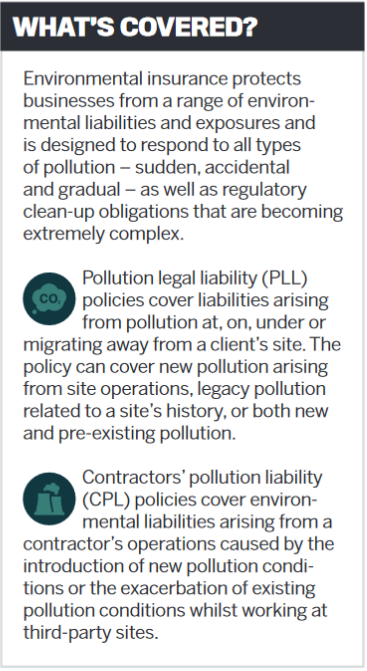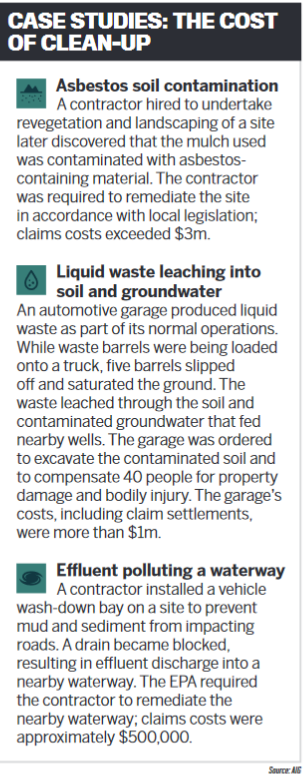

Awareness of environmental issues is growing fast. Businesses that play nicely with the world around them can no longer expect to receive a pat on the back; the public increasingly expects companies to do the right thing. Added to this is increased pres-sure from active regulators to make polluters pay. This means companies need to reas-sess their approach to environmental risk management, says Keith Gardner, environ-mental team leader, Pacific, at AIG.
“Organisations should stress-test their insurance coverage to ensure it responds as expected in the event of a loss,” he says. “Insureds think it will never happen to them, but quite clearly it can and does. We’re seeing a real gap in cover for insureds who may not believe that an environmental impairment liability [EIL] policy is necessary, so they simply rely on general liability cover, which often leaves them exposed.”This gap needs to be filled because envi-ronmental incidents are affecting a more diverse range of business than ever before. When EIL policies were fi rst conceived and issued, Gardner says, the primary focus was on heavy manufacturing industries, which were perceived to be more likely to face envi-ronmental incidents. However, over the past year, AIG has seen incidents and losses from restaurants, universities, service stations, environmental consultants, construction contractors and transportation companies, as well as from fi re events at warehouses and depots, plus the mismanagement of waste across various industries.

“Claims statistics demonstrate that an environmental incident can happen in almost any sector,” Gardner says. “It is therefore critical that brokers review their clients’ exposures and discuss ways that the client can transfer their risk.”While asbestos has traditionally been the primary cause of EIL concern in Australia, claims trends demonstrate that losses are also coming from fi re, importation of contaminated soils and leakage of hydrocarbons, which is also contaminating soil and groundwater. Fire continues to be an interesting topic for environmental risks, says Jason Thoroughgood, AIG’s head of casualty for Australia. “If your insured is concerned about their fire risk, they should also be concerned about their environmental risk.”He says the claims trends highlight the need for all contractors to have an EIL policy in place, as environmental damage can come about from any number of events.
“We have seen a number of incidents arising from the importation of contaminated soil, which is used for different reasons across the construction industry,” Thoroughgood says. “If the insured does not have proper virgin excavated natural mate-rial/excavated natural material procedures in place and something goes wrong, the cost of remediation can be signifi cant and damaging for a client’s reputation.”
So why is general liability cover not fi t for purpose for environmental incidents? First, Thoroughgood says, environmental insur-ance is a specialist line, designed to handle the complexity of environmental incidents.
“They are often complex, time-consuming and include dialogue with various regula-tors,” he says. “Second, government bodies like the Environmental Protection Agency [EPA] are becoming increasingly active with broadened powers. Their enforcement on insureds to clean up or remediate a site is becoming a lot more stringent, meaning claims costs are increasing.”
And there’s a lot at stake if a business gets it wrong. Thoroughgood cites the case of a fi re event where runo from the water used to fight a fire at a manufacturing site collected chemicals then spread them on- and o -site. The client was issued a statutory notice of clean-up by the EPA; the cost to comply was approximately $10m.
“Under a general liability policy, a statutory notice of clean-up issued by the EPA is not a trigger, because it is not a claim for third-party damages,” Thoroughgood explains. “The insured had to cover this loss. If the client had held an environmental policy, they would have had appropriate coverage and would have avoided having to fund the loss.”
So how can brokers ensure appropriate coverage for their clients? While any good EIL insurer should work with the broker to mitigate the client’s risks ahead of fi nalising a policy, incidents can and will happen. In that event, Thoroughgood says, the policy should promise to do more than just pay the claim; it should also ensure an e ective response to the pollution incident itself that minimises environmental harm.
“The client and broker should have 24/7 access to their insurer in order to seek assitance from qualified experts to respond e ectively,” he says. “The insurer should then be able to assist by coordinating clean-up experts and advising the client on next steps to ensure the safety of everyone involved.”
This kind of service from an insurer will ensure that even if the client does not have specialist environmental capabilities, they can access expertise to successfully manage the event. And given the high level of public consciousness around environmental damage, reputational risk is a huge concern with any claim, Gardner adds.
“Providing clients with access to profes-sional PR consultants at no extra cost with any EIL policy is a benefi t that brokers should seek when comparing products,” he says.
Many clients might not be aware of the envi-ronmental risks they face, much less the extent to which those risks are insurable. Because EIL is a lesser-known product, and the exposures are complex and some-times di cult to explain, education for both brokers and clients is paramount. A broker with specialist knowledge can consider the client’s environmental exposure, whether the coverage they already have (such as general liability and industrial special risk policies) is adequate and, if not, whether environmental insurance is a solution.
“By outlining how traditional policies would react versus an environmental policy, the broker ensures that the client is equipped to make their own fully informed decision on environmental risk,” Gardner says.
Brokers can also help clients pick their way through the ever more bewildering maze of regulation and legislation governing envi-ronmental liability, which can vary from one state or territory to another.
“Some local state environmental regu-lators also have the power to issue envi-ronmental protection orders to parties connected with the holder of an environ-mental authority – so-called ‘related persons’ – meaning that related corporate bodies and fi nanciers may also become liable for the environmental authority holders’ environ-mental obligations,” Gardner says.
Recognition of the need for environ-mental cover is growing in some sectors, particularly construction, Gardner says. He attributes this to two factors: fi rst, increasing legal requirements for contractors to have an environmental insurance policy in place, and second, pressure from large contractors wanting to protect their own insurance placements on lower-tier contractors to also take out their own cover.

While this is a positive trend, Gardner stresses that the broker’s role remains pivotal – especially when a company might be tempted to cut costs by ditching their environmental cover. “It is crucial for brokers to be able to highlight the critical need for EIL insurance and the risks presented if they were to opt out of cover.”
